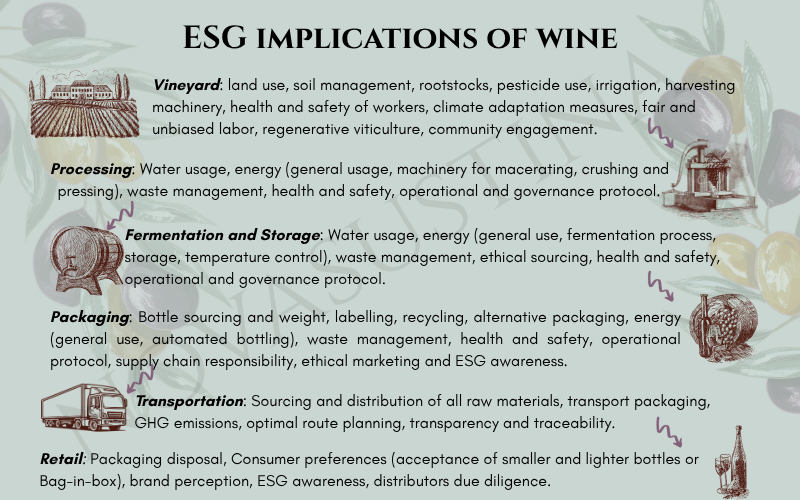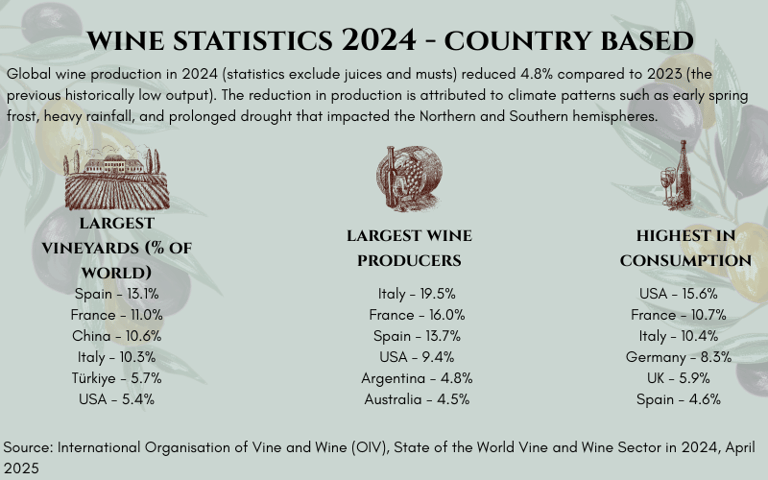WINE + ESG
A SIP OF WINE
Wine is a significant final product from grapes. Grapes provide us with multiple end products like wine, juice, vinegar, brandy, jams, grape seed oil, raisins and the fruit itself, among others. Every product has its own footprint. There's much knowledge to be spread on the progress made on sustainable wine.




MAJOR ESG ISSUES IN THE WINE INDUSTRY
PACKAGING
According to the Sustainable Wine Roundtable, wine bottles contribute to at least half the carbon footprint of wine. The SWR bottle weight accord aims to change the perspective of heavy-weight bottles to reduce their carbon footprint, keeping in mind that weight affects transportation. The SWR bottle weight accord aims to reduce the weight to 420g.
Source: https://swroundtable.org/action-areas/the-bottle-weight-accord/
SUSTAINABLE VITICULTURE
The options of organic, regenerative, biodynamic, or conventional farming practices need more collaboration and transparency. There are many labels and certification bodies of different requirements in sustainable agriculture that encourage consumers to know about what these labels entail.
WORKING CONDITIONS AND FAIR LABOR
Due diligence on seasonal workers' working conditions and health and safety in vineyards, including access to healthcare, housing, and living income.
RECYCLABILITY
Recycling packaging differs in different countries. Assessing what packaging works best for a conscious consumer to take into consideration (be it glass bottle, bag-in-box, or aluminium packaging) relies on what is most likely to be recycled in that region.
WATER FOOTPRINT
Viticulture and processing consume a lot of water. To make 1 litre of wine, at least 500 litres of water is required. (Bujdosó and Waltner, 2017). Efficient water use is a crucial aspect of ESG analysis in the wine industry.
Source: Water footprint assessment of a winery and its vineyard by Barbara Bujdosó and Istavan Waltner, Hungarian Agricultural Research 2017/1, https://www.researchgate.net/publication/316923381_Water_Footprint_Assessment_of_a_Winery_and_its_Vineyard
ADDITIONAL SOURCES
ESG LABLES AND STANDARDS OF THE WINE INDUSTRY
https://www.equalitas.it/en/sustainability/
https://www.fairandgreen.com/en/fairn-green-seal/
https://terravitis.com/en/certification/
https://www.sipcertified.org/about/people/
LIFE-CYCLE ANALYSIS OF WINE
Evaluation of the carbon footprint of the life cycle of wine production : A review by Luís Pinto da Silva and Joaquim C.G. Esteves da Silva, Cleaner and Circular Bioeconomy 2(2022)100021, 14 July 2022, https://doi.org/10.1016/j.clcb.2022.100021
Disclosure
This website does not send email alerts, newsletters, or unsolicited subscription requests. All contact is initiated through the contact form, which enables direct communication via personal email for those who wish to engage further.
All users are encouraged to read our Terms and Conditions
